Company:Tandberg
 | |
| Type | Division |
|---|---|
| Industry | Telecommunication |
| Fate | Acquired by Cisco Systems |
| Founded | 1933 |
| Founder | Vebjørn Tandberg |
| Defunct | 19 April 2010 |
| Headquarters | Lysaker, Norway |
Key people | Jan Chr. Opsahl (CEO, Chairman) |
| Products | Videoconference and telecommunications equipment |
| Revenue | US$808.8 million (2008)[1] |
Number of employees | 1,450 (2008)[1] |
| Parent | Cisco Systems |
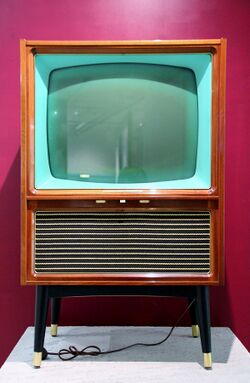
(Oslo, Nordic Museum)

Tandberg was an electronics manufacturer located in Oslo, Norway (production, sales and distribution) and New York City , United States (sales and distribution). The company began in the radio field, but became more widely known for their reel-to-reel tape recorders as well as cassette decks[2] and televisions. The original company went bankrupt in 1978, after a sharp financial downturn. The following year, the company re-formed whilst their data division was split off as Tandberg Data, including the tape recording division, which reduced its scope to data recording.
Over time the original Tandberg company became increasingly involved in the teleconferencing systems, and became a leader in that field. The company's main competitor was Polycom and other competitors were HP, Sony, Radvision, VTEL and Aethra.[3]
Cisco Systems acquired Tandberg on 19 April 2010.[4] Tandberg Data is now officially a Germany company, and continues to make computer tape storage systems.
History
Tandbergs Radiofabrikk
The company was founded by Vebjørn Tandberg as Tandbergs Radiofabrikk (Tandberg's Radio Factory) in Oslo in 1933. The company's first radio was named "Tommeliten" (Tom Thumb), and used only earphones. This was followed by the "Corona" with a loudspeaker. In 1934, the first "Huldra" radio was launched, followed in 1936 by the "Sølvsuper". During the early years, radios, loudspeakers and microphones were the main output from the factory. The Sølvsuper and the Huldra radios became the foundation for Tandberg's success.
In the early 1950s, Tandberg opened a branch plant at Kjelsås[5] (in Oslo) to produce reel-to-reel tape recorders. Their first model was introduced to the market in 1952. Over the next decade, Tandberg quickly incorporated a number of leading-edge concepts; the model 2 Hi-Fi of 1956 had three tape transport speeds, allowing improved high-frequency response. The model 3 Stereo from 1957 was Tandberg's first stereo system which allowed playback of stereo tapes, however the ability to record in stereo was not made available until the introduction of the model 5 in 1958, which allowed for the connection of an external recording amplifier to record the second channel onto the tape. Their first full stereo system, the model 6 of 1960, featured four amplifiers, two for recording and two for playback respectively, giving the operator total control of both audio channels. In the 1960s, Tandberg introduced the cross-field recording technique in the model 6X, allowing their recorders to handle higher frequencies than competing models. Tandberg licensed the concept to Akai, who utilized it extensively in the 1970s and 80s, in their Akai and Roberts recorders. In 1964, Tandberg inaugurated a new method of language teaching, the language laboratory, and with it their first fully transistorized tape recorder, the model 10, a recorder designed to serve as the teacher recorder in language classrooms. However the first transistorized recorder marketed to consumers was the model 12 of 1966, which among other things featured low impedance microphone inputs, designed for their first dynamic microphone, the TM 4. In 1969, Tandberg finally abandoned the use of vacuum tubes in their recorders, and the 6X which had introduced cross-field recording to the world, the last tube recorder still manufactured by Tandberg, went out of production. That same year a new lineup of transistorized Tandberg recorders entered the market to fill the gap left by the preceding models.
Tandberg tape recorders dominated the Norwegian market, and had a reputation for advanced technology and high quality at reasonable prices. It was on Tandberg reel-to-reel machines that President John F. Kennedy recorded many meetings in the Cabinet Room of the White House, including those associated with the Cuban Missile Crisis.[6]
The Kjelsås factory also started producing TV sets in 1960, and in 1966, a second TV plant was opened in Kjeller in Skedsmo. Colour TV's were added to their lineup in 1969. In 1972, Tandberg purchased Radionette, another large Norwegian electronics firm now focusing on televisions. By 1976, TVs were Tandberg's major product and their factories employed 3,500. However, that same year a major economic downturn seriously disrupted the company, and by 1978, it was insolvent. A shareholder revolt removed Vebjørn Tandberg from control of the company, and he committed suicide in August. In December, the company declared bankruptcy.
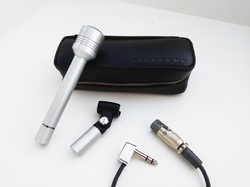
Split-up
In the aftermath of the bankruptcy, the original Tandberg was split into two parts. Under the control of Siemens, Tandberg Data took over the computer terminal and tape recording parts of the company, moving the latter purely into the computer storage field. The remaining portions went under control of Norsk Data and lost the "Radiofabrikk" to become, simply, Tandberg.
Tandberg continued to develop audio technology including Actilinear and Dyneq.[7][8][9][10]
In 1984, the consumer audio equipment division was spun off to become Tandberg Audio.[11]
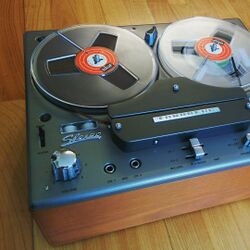
Tandberg's first picture telephone for ISDN was developed in 1989, while the fully integrated Vision H.320 picture telephone was launched in 1993. Subsequently, focus moved to higher performance systems – the Grand Vision and the Master Vision series. New desktop endpoints were also added – the Compact Vision and the Vision600.
The first US office opened in 1995 in Connecticut. It was moved to Kansas City for a short period before moving to Reston, Virginia in August 1996. In 1997, the company acquired two sales and distribution companies in North America, establishing a firm foothold in the single largest videoconferencing market in the world. It created two large sales and support offices in the US, one in Virginia and the other in Texas. The office in Reston, Virginia remains the largest office in the US to this day.
Also in 1997, the television manufacturing portions became Tandberg Television.
In 1999, the company acquired the Norwegian technology company Internet Technology AS which had developers experienced with the ITU H.323 standard, especially from VoIP-projects like the world's first commercial H.323 VoIP service launched in 1997 with Telenor.[12]
In 2000, the company moved into IP-based videoconferencing using the maturing H.323 standard, making the entire product line IP-capable. Since 2000, the company has expanded its product line greatly, by adding enterprise-class MCUs, gateways, service-provider class MCUs and H.323 gatekeepers. In 2001, the company also acquired a consultancy company Delante AS which enabled it to focus more on external software integration and bindings, especially the Microsoft platform. In 2004, Ridgeway Systems and Software, a UK-based software house specializing in firewall and NAT traversal, was acquired. The result of this acquisition was the Tandberg Expressway Firewall Traversal technology, which allows any H.323 video endpoint to place calls through any number of firewalls or NAT devices.
In July 2004, the company released a major new endpoint product line, the "MXP" series.[13]
In February 2005, the company released SIP software for all its video endpoints, as well as a major update to its SCCP based video systems.
In July 2005, the company acquired IVIGO from TNO Telecom. IVIGO, based in the Netherlands, developed and successfully commercialized circuit-switched video solutions for UMTS network operators, vendors and content providers. The IVIGO 3G-to-H.323 video gateway is now used by Tandberg's high-end visual communications systems to connect over video to 3G handheld phones.
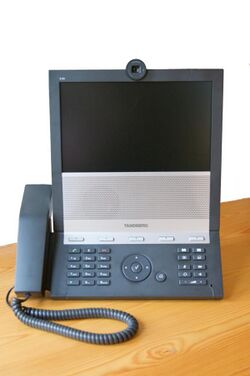
In September 2005, Cisco Systems officially launched the Cisco 7985G, a Cisco-Tandberg co-branded desktop videophone.
In October 2005, the company acquired Ectus, a New Zealand-based software development company specializing in streaming and archiving software.[citation needed]
On 16 December 2005, Andrew Miller stepped down as CEO, replaced by the CFO Fredrik Halvorsen. Halvorsen was a relatively new hire with a background from McKinsey.[citation needed]
In September 2007, the company acquired Codian, a rival developer of video-conferencing infrastructure products, for $270 million in cash and shares.[14]
In 2009, the company introduced the full-HD "C-series" endpoint product line, including the "EX-series" desktop appliances, progressively replacing the previous "MXP" product series.
In October 2009, Cisco Systems made a $3 billion recommended offer to acquire Tandberg.[15] After upping its offer to almost $3.4 billion, Cisco announced on 4 December 2009, that over 90% of Tandberg's shares had been tendered, allowing it to squeeze out the remaining shareholders.[16][17][18] In February 2011, Tandberg was officially rebranded to Cisco, however the Tandberg name continues to be extensively used (as of mid 2011).
Codian
Codian is a former supplier of video conferencing products. The company became part of Tandberg in 2007. Codian was founded in 2002, and based in Langley, Slough, UK. Its main products included Multipoint Control Units and gateways. It was acquired by Tandberg in 2007 for US$270 million[19] and its products continued to be sold under the "Tandberg Codian" brand name. Codian products are still supported and developed by Cisco under the same brand name, and Codian's original technology was used by Cisco to develop its own line of TelePresence servers.
Companies sharing the name
There are also other companies called Tandberg with roots in the same parent company, although not necessarily with common ownership:
- SANAKO/Tandberg Educational
- Tandberg Audio
- Tandberg Unterrichtstechnik (Deutschland)
- Tandberg Data
- Tandberg Storage
- Tandberg Telecom – fully owned subsidiary
- Tandberg Television
Products
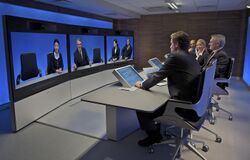
- Immersive Conferencing systems: Tandberg T1 & T3,[20][21]
- Personal systems such as desktop systems, video enabled VOIP phones and video-conferencing solutions for mobile phones and tablets[22]
- Call Control systems like the Video Communication server or the enterprise level Unified Communications Manager[23]
- Videoconference Manager: Cisco Telepresence Manager and the software suite to manage the CTM. The CTM makes it possible to connect any device in a single "Telepresence" conference call[24]
- CTM Director for enterprise wide management of all CTM endpoints[25]
- Infrastructure systems:
- Telepresence server
- MSE 8000 series multipoint video conferencing systems[26]
- MCU conferencing bridges: MCU 4200 and 4500 series[27]
- Media Processing System: MPS200 and MPS800[28]
- Cisco Telepresence multipoint switches: combine any type of TP endpoints in one call[29]
- Infrastructure: Advanced Media Gateway, IP Gateway server, IP/ISDN Gateway servers and content servers[30]
- Conference recorders: Tandberg IP VCR and Cisco Telepresence Recording server to allow recording of multipoint video conferences[30]
- Video conferencing cloud services: enable video conferences between different companies crossing one's own (network) borders, but maintaining high level of security.
With the supporting system included in the Immersive systems or dedicated management servers, all these systems can interact with each other and be used in one conference session: people using a video-enabled smartphone or tablet can participate in a conference-call setup using the CTS models, and everyone automatically receives both optimal image quality and features for their system. The propriety protocol used in the Immersive TP systems can interact with industry open standards used in mobile phones, tablets and video-enabled VOIP devices regardless of their vendor: any device can connect to any other system[24][29] The product portfolio of existing Cisco video conferencing solutions and the Tandberg systems are now combined in one portfolio. The Tandberg product names have changed, but they are still being offered using the Tandberg brand name, and overlaps still remain in the portfolio.[31]
Controversy
In November 2010, Fiona Glaser, an x264 developer, published information in which she claims that one of Tandberg Telecom's patent applications from December 2008, contains a step-by-step description of an algorithm she committed to the x264 codebase around two months earlier.[32] This was relayed by media, which remarked that the employee who filed the patent was following the x264 project IRC development channel and was known to the project developers,[33] leading to Tandberg claiming that they discovered the algorithm independently. Copies of e-mails that demonstrate this, together with an affidavit and an Information disclosure statement was filed by Tandberg with the United States Patent and Trademark Office in June 2011. [34]
References
- ↑ 1.0 1.1 1.2 1.3 "Annual Report 2008". Tandberg. http://www.tandberg.com/collateral/ir/TANDBERG-2008-Annual-Report-English.pdf. Retrieved 4 December 2009.
- ↑ Test Cassettendecks with Tandberg TCD 3014 A, 1988 (PDF, 6 MB), retrieved 22 May 2020.
- ↑ Hermann Simon mentioned this company in his correspondent Book as an example of a "Hidden Champion" (Simon, Hermann: Hidden Champions of the 21st Century : Success Strategies of unknown World Market Leaders. London: Springer, 2009.- ISBN:978-0-387-98147-5.)
- ↑ "Acquisitions" (in en). https://www.cisco.com/c/en/us/about/corporate-strategy-office/acquisitions.html.
- ↑ "Et lite stykke Norge". 19 June 2012. http://www.dagbladet.no/2012/06/19/kultur/analog_digital/musikk/hi_fi/audiofilt/22169110/.
- ↑ The Presidential Recordings: John F. Kennedy, The Great Crises. 2. New York: Norton. 2001. p. xvii.
- ↑ "Archived copy". http://www.ant-audio.co.uk/Tape_Recording/Theory/Tandberg_Actilinear_Dyneq.pdf.
- ↑ "Archived copy". http://sportsbil.com/tandberg/tcd-440a-tech.pdf.
- ↑ Information, Reed Business (20 September 1979). "New Scientist". https://books.google.com/books?id=qRX86BSfebUC&pg=PA889.
- ↑ Fantel, Hans (2 September 1984). "Sound; A Standout Cassette Deck". The New York Times. https://www.nytimes.com/1984/09/02/arts/sound-a-standout-cassette-deck.html.
- ↑ "Tandberg-innhold". 2012-11-07. http://www.nrhf.no/Tandberg/nrhf-TR-innhold.html.
- ↑ "Tandberg blar opp 24 mill. for Internett-selskap". 1999-09-28. https://www.digi.no/artikler/tandberg-blar-opp-24-mill-for-internett-selskap/331206.
- ↑ "Tandberg Introduces Breakthrough Technology That Transforms Video Communication Experience". http://www.tandberg.com/press_room/viewPressRelease.do?id=74.
- ↑ "Tandberg to acquire Codian" (in en). https://www.networkworld.com/article/909344/tandberg-to-acquire-codian.html.
- ↑ Clark, Andrew (1 October 2009). "Cisco makes £1.8bn move to take over Norway's Tandberg". The Guardian (UK). https://www.theguardian.com/business/2009/oct/01/cisco-tandberg-takeover-technology. Retrieved 1 October 2009.
- ↑ Solem, Richard; Virki, Tarmo (4 December 2009). "Cisco gets Tandberg shares after fierce battle". Reuters. https://www.reuters.com/article/idUSGEE5B30WA20091204. Retrieved 27 September 2010.
- ↑ "Tandberg Cisco". VideoCentric. http://www.videocentric.co.uk/videoconferencing/tandberg-videoconferencing/tandberg.shtml. Retrieved 5 January 2010.
- ↑ Vance, Ashlee (1 October 2009). "Cisco Buys Norwegian Firm for $3 Billion". The New York Times. https://www.nytimes.com/2009/10/02/technology/companies/02cisco.html. Retrieved 13 April 2020.
- ↑ Meserve, Jason (2007-09-06). "Tandberg to acquire Codian". Network World. http://www.networkworld.com/article/2348738/tandberg-to-acquire-codian.html. Retrieved 2015-05-02.
- ↑ T1 and T3 portfolio Multipurpose room systems
- ↑ Video conferencing products
- ↑ Personal Video conferencing portfolio
- ↑ Tandberg website on Call Control products
- ↑ 24.0 24.1 Cisco CTM brochure, PDF document, retrieved 27 February 2011
- ↑ Tandberg CTM Director software, visited 27 February 2011
- ↑ MSE 8000 series documentation, visited 27 February 2011
- ↑ Tandberg MCU brochure, retrieved 27 February 2011
- ↑ Tandberg product documentation of the MPS 800 series, visited 25 February 2011
- ↑ 29.0 29.1 Cisco product documentation on the CTmS switches, visited 26 February 2011
- ↑ 30.0 30.1 Infrastructure information, visited 27 February 2011
- ↑ Tandberg Telepresence Product brochure, PDF, downloaded 24 February 2011
- ↑ Fiona Glaser (November 2010). "Patent skullduggery: Tandberg rips off x264 algorithm (original post)". x264.nl. http://x264.nl/developers/Dark_Shikari/tandberg.html. Retrieved 28 November 2010. "So why the deja vu? Because this patent application was an exact, step-by-step description of the algorithm I came up with for decimate_score (and later coeff_level_run) in x264 in 2008!"
- ↑ "Tandberg coder accused of open source theft". thinq.co.uk. 26 November 2010. http://www.thinq.co.uk/2010/11/26/tandberg-accused-open-source-theft/. Retrieved 28 November 2010.
- ↑ "Rule 130, 131 or 132 Affidavits - Patent Application Information Retrieval for 12/649,764 METHOD, APPARATUS, AND COMPUTER READABLE MEDIUM FOR CALCULATING RUN AND LEVEL REPRESENTATIONS OF QUANTIZED TRANSFORM COEFFICIENTS REPRESENTING PIXEL VALUES INCLUDED IN A BLOCK OF A VIDEO PICTURE". uspto.gov. 16 June 2011. http://portal.uspto.gov/external/portal/pair. Retrieved 13 September 2011.
External links
- Official site
- Private Tandberg classics site
- (in Norwegian) History of Tandbergs Radiofabrikk 1933–78
[ ⚑ ] 59°54′28.83″N 10°37′8.37″E / 59.9080083°N 10.6189917°E
 |

